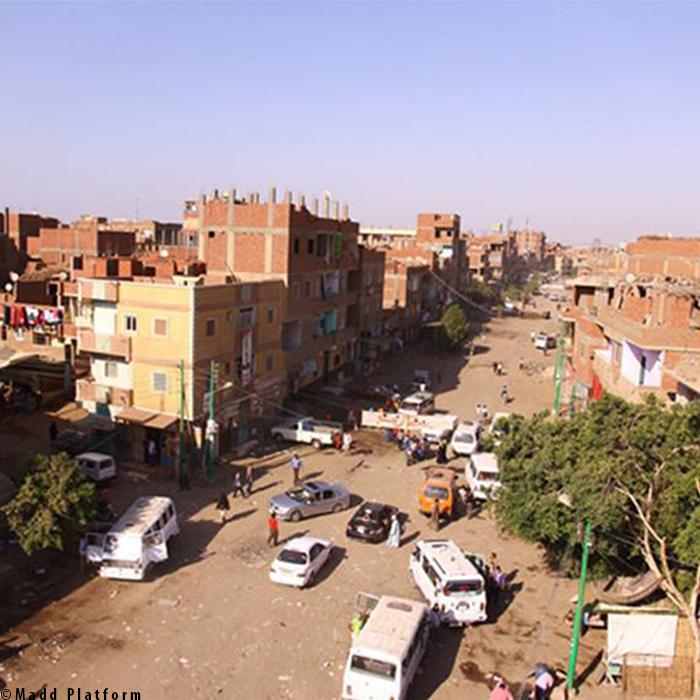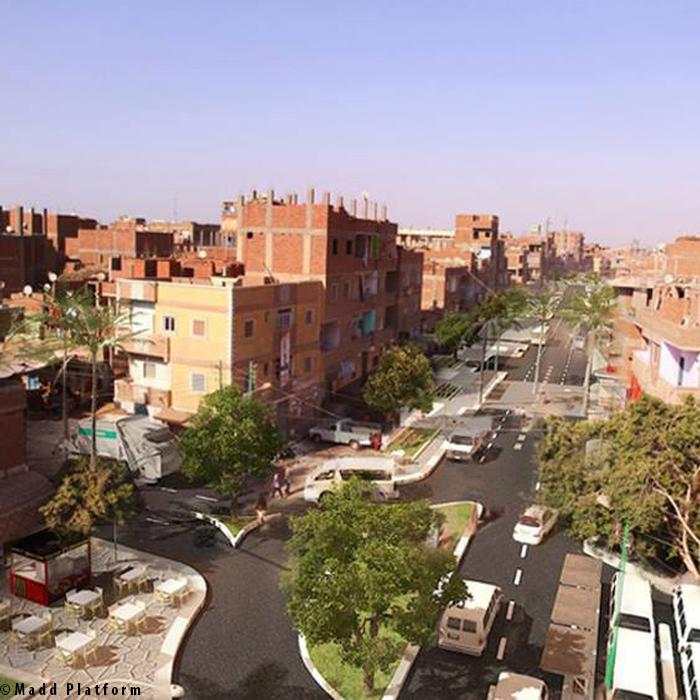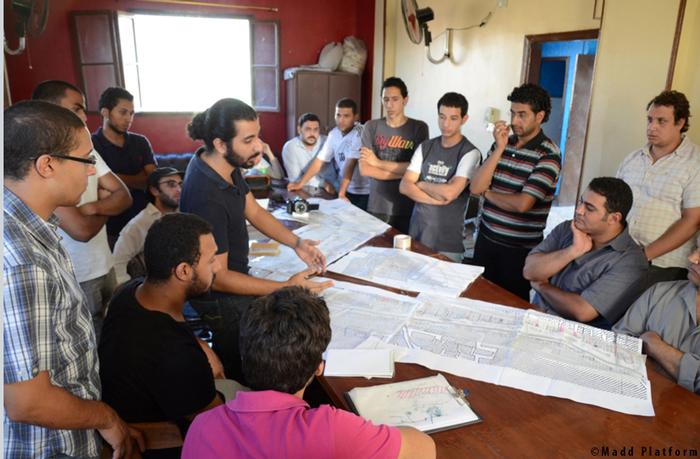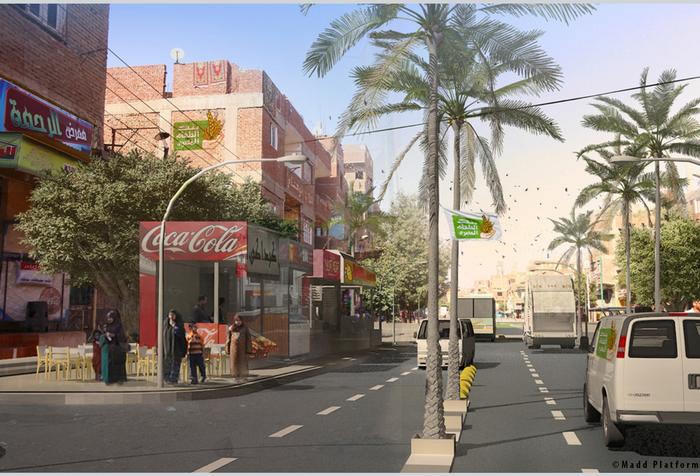Eman Zied EssayParallel Practice: Bottom-Up Participatory Design in Impoverished Communities in EgyptIn Egypt, urban design problems are tackled with arbitrary top-down measures; areas get ‘redeveloped’ while others are ignored. By redeveloped I mean cleared away for posh skyscrapers, a steady process of gentrification. This partially stems from classism that’s prevalent in Egyptian society, where the upper classes, monopolizing wealth and power, take design and redevelopment decisions that affect working classes without consultation, often with devastating results. To combat this, Madd Platform, an independent group of urban designers and researchers, created a method of participatory design, reversing the process and taking steps to eradicate poverty through urban design initiatives. “Why're you nice to the cleaning lady?” My flatmate asked, after hearing me thank the housekeeper. The question is innocuous, what’s interesting is the reason behind it. I wouldn’t describe my flatmates as snobs, but this question stems from internalised classism. As students attending a private university, we belong to the Egyptian upper-middle classes and above. The housekeepers however, belong to the Egyptian working class. I was born in Egypt but lived in England for most of my life, returning to Egypt when I was 14. From that perspective it struck me as odd how casually people from lower classes were dismissed as lesser, by virtue of being working class, some students subconsciously believe being polite to the housekeepers isn’t worth it. One of the causes of this disparity in class in Greater Cairo is due to the migration that happened during the 1950’s. Development is concentrated in Cairo and targeted to the wealthy, so people move out of the countryside to work because they have no opportunities otherwise. The sheer numbers overwhelm the infrastructure, in turn, the overall quality of life is lower, and in some cases, the areas where the poorest sector of society lives are informal settlements with no governmental presence. Even though they are mostly neglected by the government unless they’re standing in the way of large investment projects, the aforementioned settlements have drawn the attention of urban designers and architects; Madd Platform being one of these groups. I had the opportunity to speak to architect Ahmed Zaazaa. He, along with architect Mohamed Abotera, founded Madd Platform after the 25th January Revolution, when many other groups were starting to form, to tackle various social issues in Egypt. The theoretical framework that Madd Platform operates within focuses on relationships between stakeholders to create a parallel participatory approach that benefits the community of the project as well as its more powerful stakeholders. They focus on strategic vs. tactical space – how spaces are designed vs. how they are used by people. Madd Platform aims to reverse the process of top-down design, giving the community a voice and putting them in charge of the development of their area. ‘Madd’ in Arabic means extension, signifying the extension of bridges between different sectors of society, a standing metaphor for their objective, acting as a mediator between different stakeholders. The top-down design problem is cyclic, with the higher-ups making poor decisions that harm the people living in communities targeted for redevelopment. These people become mistrustful of architects and designers, and don’t co-operate when representatives collect information. I, and other students of architecture, have experienced this first-hand. In field research, especially in poorer districts, people are unwilling to speak to us and one of the most common answers when they do is: ‘Everything is fine, we don’t need change’. The project I researched is their first project, in Al Kum Al Ahmar, a village of 35,000 inhabitants, north of Imbaba in the Giza governate. Built mostly illegally on agricultural land due to lack of accommodation elsewhere, the village lost its identity, transforming into an unfinished red-brick and concrete settlement; the Egyptian equivalent of slums. In its earlier days, this village was a thriving hub for car mechanics with regular Giza clients. After the roads deteriorated, the village became inaccessible. Its neighbours couldn’t risk getting their cars over there for fear of damaging them further. The degeneration in their built environment was the direct cause of their livelihood being destroyed, leading to their spiral into poverty. A group of people within the village approached Madd Platform during an event held by Revolutionary Municipalities; another urban initiative set up after the revolution. The village had secured funding from Coca-Cola through their Corporate Social Responsibility program and the Egyptian Food Bank. The village needed designers to concisely present their initiative, lest the investors pull out. The immediate problems the community faced were primarily due to the fact that the main street, Jaziret Mohamed, running through the village had degenerated, leaving them with little income generation. They had no police station due to it being an informal, illegal settlement, the public transport system was in shambles, public space was nonexistent and they were not connected to their neighbours; Usim, another district, and Cairo, the Egyptian capital. The village couldn’t rely on the government to fix these issues so instead turned to Madd Platform. To start, Madd Platform met with the residents in focus groups and started collecting information. Parallel to the interviews, the design team studied the behavioural patterns of the people and drew a map, showing the movement of traffic and pedestrians over two days, a Sunday and a working day midweek. The designers met with another problem during focus groups, where the women and girls were reluctant to speak up in their male dominated environment about their contributions. When they did, their requests were simple; namely a place to meet and socialise together. This goes back to the deep internalised subjugation of women, a common cross-class issue prevalent in middle-eastern communities. From the focus groups, the residents put forward their requests and complaints. The space around the street, currently unpaved and dusty, was used by car mechanics and street-side coffee shops, intermingled with parked microbuses. It was difficult and dangerous to navigate, with children often falling victim to hit-and-runs. There were no green areas, very few trees, and no spaces for children to play. There was a weekly souq (outdoor marketplace) but it didn't adequately serve the needs of the residents. The entrances from Usim and Cairo to the village were indistinct and unwelcoming. In short, it was chaotic, inaccessible and unhealthy public space that didn’t reflect the community’s needs. The village needed organisation and income generation, and the best way to do this was to acknowledge how the space was already used and build upon it. One of the first things Madd Platform decided was that the street needed to be paved, to stop it from damaging vehicles and reduce the amount of dust and dirt in the air. The second strategy targeted the main nodes within the street. The three main focus points in Jaziret Mohamed were the two entrances and the village centre, each marked by an intersection. The entrances were redesigned to be welcoming, with speed bumps added to ensure safety and palm trees and greening added for a healthier atmosphere. In the village centre the daily souq and the playgrounds the residents requested were placed, with bus-stops nearby as part of the organisation of public transport. Further down the street a memorial was constructed as tribute to the two residents who lost their lives in the 25th January Revolution. The rest of the street was dedicated to income generation and accessible public space. The main income generation method was the redesign of the public spaces around the street. This involved setting up fifty kiosks, fifteen small coffee shops and fixing the space in front of the existing shops and seventy two car mechanics which would be rented out cheaply. The redesign created a better environment to work in and the money from the rent is reinvested into the village to maintain that environment. The width of the street had played a part in its degeneration. At 35 metres wide, it was too wide for a village of that size and impossible to be controlled or maintained. In the redesign, this width was used as an opportunity to place islands, bus stops and green spaces within the street itself, and move the pavement closer and further from the buildings, with respect to their owners’ territoriality. In the commercial areas, the pavement was moved closer to the buildings, whereas in the residential areas it moved closer to the street. This strategy helps retain the sense of ownership in space, and thus ensures their regular maintenance. Women and girls were given their own space, directly in front of the existing girls ‘school. Since some of the girls were not being educated, this space offered them a place to meet and socialise. It contained an internet café, library and small theatre. After the design was complete, Madd Platform presented it to the residents who gave feedback on the design. This process was repeated twice, with the residents’ comments being taken into consideration. The design was modified until they were satisfied with the product, which was then presented to the governor of Giza by Madd Platform, who gave them approval to start construction. Fixing the road and public spaces directly fixed their livelihoods and thus improved their socioeconomic status; a direct act of social architecture. People could come fix their cars again. Even though the implementation of the project is slow, the community response is positive since they were involved from the start of the project. They were afforded spaces they needed and issues they cared about were respected. A close example is the statue for the martyrs and spaces for the girls. The output of the project was presented in a way that speaks to the everyday user, not only to other designers, in the form of easily readable maps and before-and-after pictures. In the village nearly everybody is of the same social class, with slight differences in wealth and education levels. This project serves nearly all of the sectors of that community, whether directly, by giving them a new method of income generation, or indirectly by improving the environment in which they live, play and work. On a larger scale, the project reconnects the village with its direct neighbours, Usim and Cairo. The ends of the road were left open so development could continue to the surrounding villages. Fixing the road means that it’s easy to access Usim and the Ring Road, the main highway around Cairo, to connect it to the rest of Cairo. The project, being small-scale, received little promotion so the surrounding villages don’t have much of an idea about what’s happening nearby. Once the project is completed, it is hoped to attract similar community-based initiatives. This project also starts the process of slowly knitting together the urban fabric of Greater Cairo. While the Ring Road was initially built to limit the expansion of Cairo, informal settlements like Al-Kum Al-Ahmar began popping up on the other side of the Road, contrasting with the planned settlements of the New Cairo gated compounds. Linking together the informal fabric with the formal infrastructure via projects such as this ensures that residents receive the same standard of services and utilities and thus taxed and accounted for accordingly. This first project was presented as a prototype model in architectural research circles, in the Learning from Cairo symposium held at the American University in Cairo where it was positively received. Madd Platform has also done several presentations in other universities, which is where I initially heard about them and their projects. Since this project was small-scale, it didn’t get national news coverage, but Madd Platform have featured in several articles by national newspapers like Ahram News, about other, larger scale projects like the Maspero Triangle and making a new administrative capital city for Egypt. The initial government response was positive. The governor of Giza agreed to set aside funding for the first 500m of a 1200m street. The project's design was finished in June 2011, and work started in December 2011, eventually, work tapered off until it came to a standstill. The rest of the project couldn't start until the asphalt was finished, so Madd Platform took it higher than the governor. Talks have been taking place between Madd Platform and the Minister of Housing and Development to change government policy to fund this project and others like it. This raised the idea of having official local representatives, to act as mediators between the communities and municipality. They would have an official salary and a fund would be set aside by the government to be used for community development. I believe that architecture is for the people. We create spaces to be used by the ordinary people, not to be looked at and admired by other designers. This design process is a good step, even if it takes longer to carry out. Involving the community in this way ensures that their needs are respected. The feedback loop is important; to make sure what is designed is actually what the residents requested. Part of this approach can also be integrated into the more traditional top-down design process. The designers or investors can approach the residents with a project which can then be fine-tuned after the residents give their feedback on it. One of the drawbacks of parallel participation is that it requires real community participation, so if the residents are not able or willing to engage with the designers out of fear or mistrust then the whole process falls apart. The design process itself works, but it requires active participation, full transparency and genuine consent from all the parties involved to turn conflicting issues into common interests. In hindsight, I wouldn’t change the actual design process, rather increase the media coverage and promotion for projects of this nature by using two approaches, one aimed at the communities that the projects would work within, and one aimed at the upper classes with the power to influence government policy. Without awareness, social attitudes won’t change. Residents living in informal settlements in need of urban intervention should know that it’s their right to receive the same level of services that the privileged communities take for granted. On the other hand, these privileged communities should be aware of the living conditions of their –often close- neighbours, stop seeing them as statistics and treat them as real people. Apathy can be more destructive than we think. Internalised class attitudes limit participation in public life, thus problems remain unsolved and people remain entrenched in poverty. Giving marginalised users a voice in the design of their environment gives them the confidence and know-how to speak out and make a difference, without neglecting the interests of other stakeholders. This is what makes it parallel participation- everyone has a voice and everyone is on equal footing. By integrating elements of this approach such as the feedback loop into the existing system we can reach a middle ground and start bringing about change in urban design approaches and class attitudes that we so desperately need. In the end, we're all people, and we all need somewhere to thrive, not just to survive.
Additional Help and InformationAre you in need of assistance? Please email info@berkeleyprize.org. |
|




